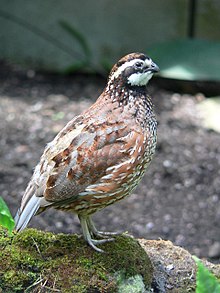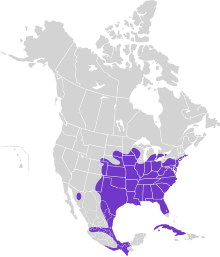| Northern bobwhite Temporal range:
| |
|---|---|

| |
| Adult male | |

| |
| Adult female | |
| Scientific classification | |
| Domain: | Eukaryota |
| Kingdom: | Animalia |
| Phylum: | Chordata |
| Class: | Aves |
| Order: | Galliformes |
| Family: | Odontophoridae |
| Genus: | Colinus |
| Species: | C. virginianus
|
| Binomial name | |
| Colinus virginianus (Linnaeus, 1758)
| |
| Subspecies | |
|
23; see text | |

| |
| Synonyms | |
| |
The northern bobwhite (Colinus virginianus), also known as the Virginia quail or (in its home range) bobwhite quail, is a ground-dwelling bird native to Canada, the United States, Mexico, and Cuba, with introduced populations elsewhere in the Caribbean, Europe, and Asia. It is a member of the group of species known as New World quail (Odontophoridae). They were initially placed with the Old World quail in the pheasant family (Phasianidae), but are not particularly closely related. The name "bobwhite" is an onomatopoeic derivation from its characteristic whistling call. Despite its secretive nature, the northern bobwhite is one of the most familiar quails in eastern North America, because it is frequently the only quail in its range. Habitat degradation has contributed to the northern bobwhite population in eastern North America declining by roughly 85% from 1966 to 2014.[4] This population decline is apparently range-wide and continuing.[5][6]
There are 20 subspecies of northern bobwhite, many of which are hunted extensively as game birds. One subspecies, the masked bobwhite (Colinus virginianus ridgwayi), is listed as endangered with wild populations located in the northern Mexican state of Sonora and a reintroduced population in Buenos Aires National Wildlife Refuge in southern Arizona.
- ^ BirdLife International (2021). "Colinus virginianus". IUCN Red List of Threatened Species. 2021: e.T22728956A178045540. Retrieved 30 March 2022.
- ^ "NatureServe Explorer 2.0". explorer.natureserve.org. Retrieved 30 March 2022.
- ^ "Northern Bobwhite". World Bird Info. Archived from the original on 1 August 2013. Retrieved 3 May 2013.
- ^ "Northern Bobwhite". Cornell University. Retrieved 14 February 2017.
- ^ "The 116th Christmas Bird Count Summary". National Audubon Society. 21 November 2016. Archived from the original on 22 February 2017. Retrieved 22 February 2017.
- ^ "BBS Trend Maps - Northern Bobwhite Colinus virginianus". Patuxent Wildlife Research Center. Archived from the original on 30 August 2019. Retrieved 6 December 2018.

